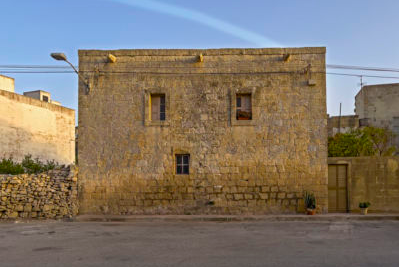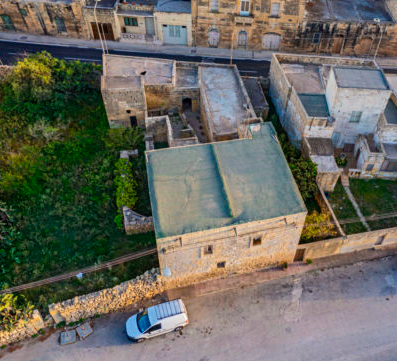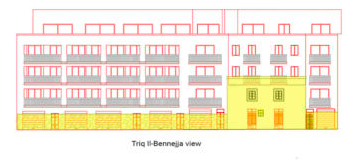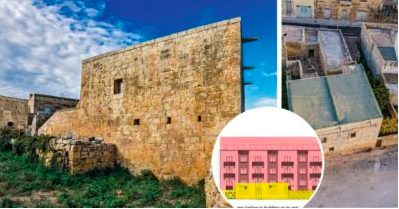A block of 32 flats in Gozo, fronted by an engineer but belonging mostly to Joseph Portelli and associates, has been granted development permit after the Planning Authority inexplicably dropped its reason for refusal of the engulfment of a centuries-old farmhouse.
Heritage experts consulted by Lovin Malta expressed consternation at the PA’s decision, and said that the old house in Xewkija holds vernacular, historical features worthy of protection.
The application was fronted by Mark Falzon, an electrical engineer who declared in the application form that he was “not an owner of the entire site, but I am authorized to carry out such proposed development through an agreement with the owner.”
The block of flats, which was given final clearance to proceed two weeks ago, will see one of the two old houses on site demolished, and the older one have its roof lopped off and its remaining, skeletal walls subsumed in the large block of flats. A car park will be dug underground all around the remaining old building.
The applicant, Mark Falzon, submitted two successive development applications, with the second one being granted after a different case officer left out the engulfment of the old house as a reason for refusal. This despite having been an “important consideration” in refusing the first application.

In response to the first application, for a block of 38 flats, the Superintendence for Cultural Heritage wrote to the PA that the building is of “evident vernacular and historical value” and had to be “retained in its entirety, with minimal interventions.” It called for the “proposal to be revised to avoid engulfing the vernacular building with resultant loss of legibility of the historical structure.”
The PA then adopted the stance and language used by the Superintendence, adding that the development was in breach of policies which “seek to preserve buildings of cultural heritage.”
It rejected the proposed development on 20 October 2020.
Six days later the applicant lodged a new application, reducing the number of flats to 32 but keeping the scale and volume virtually unchanged except for an overall reduction in height on half of the building by around 1.5 metres and receding the façade on top of the old farmhouse by around another metre.
Then the architect, Angelo Portelli, appealed against the refusal of the first application 11 days earlier. Appeals are heard by the Environment and Planning Review Tribunal.
In this way, the developer mounted a two-pronged fightback strategy: an appeal against the rejection of the first application in front of the tribunal, and simultaneously putting in a second development application with marginal changes in scale and volume in front of the PA.

Flats had long been on sale anyway
Before all of this started, before the first application was lodged, way back on 13 January 2020, the applicant Mark Falzon began promoting the flats for sale on Facebook, with the price starting from €50,000. Twelve days later the flats also appeared – similarly priced at €50,000 – on Malta Park.
Falzon then applied on 18th February, with the proposal refused on 20th October, nine months after he and gelgul started offering the flats for sale for €50,000.
Gelgul is the name given by the seller on Malta Park, who described himself as the ‘developer/owner’.
Investigations by Lovin Malta identified gelgul as Joseph Vella, who works as a store-keeper at Ta Dirjanu supermarkets.
Ta Dirjanu is owned by the Agius family, including brothers Mark and Joseph who own Agius Projects Limited. This company is one of three owners of Excel Investments Limited. The other shareholders are Daniel Refalo and property magnate Joseph Portelli, who is the largest shareholder.
The name Joseph Vella has appeared on three other applications of developments belonging to Excel or any of its owners. Two of these were for blocks of 28 flats and 66 flats in Xlendi. The third is for a block of 29 flats at Ta Sannat.
The Planning Authority granted permit to the flats in Sannat last month despite widespread opposition. In that application form Vella declared himself to be “an owner of the entire site” on which the development would take place. Asked by Lovin Malta last September whether he denies or confirms making a false declaration of ownership, he declined to comment in any way.
He was contacted again this week in connection with this article, and asked if the flats he had been selling belonged to his boss, Mark Agius, and associates, including Joseph Portelli. He said he had clients and could not talk.
Vella is active in civil society organisations involved in celebrations of the town feast as well as other events in his native Xewkija. He is one of the main organisers in next month’s event titled Christmas in the Square, which is endorsed or supported by the local council. His sister is a councillor.

Superintendence ignored in second application
In its submissions for the second application of 32 flats, the Superintendence of Cultural Heritage twice reaffirmed the stance it had taken in the previous incarnation of the application that had been refused. It reiterated that the proposal had to be “revised”, possibly by opting for a stepped design, to “avoid engulfing the vernacular building with the resultant loss of legibility of the historic structure.”
And the Planning Authority also maintained this point in its submissions to the tribunal that was hearing the applicant’s appeal against the first refusal. The authority defended its refusal by saying that the “existing old building fronting Triq Il-Bennejja, which is significant due to its vernacular value, is not being retained entirely.” It called this an “important consideration.”
But several months later, in the case officer report on the second application, this “important consideration” did not result in a reason for refusal as it had done in the first application run. And this despite the fact that the second application signified an even greater intervention to the integrity of the old building than the first application – in the second application, the block of flats would, in addition to subsuming the house, lop off the roof and upper walls.
The report on the second – written by Antoinette Schembri and endorsed by Sylvana Zammit – still recommended refusal by making the overall point that the block of flats would not ‘respect and enrich its context’, or ‘protect or enhance the character and amenity of urban areas’.
But the Planning Commission – with the report now devoid of the most irreconcilable impediment for refusal – turned the recommendation for refusal into an engagement with the architect to address the reasons for refusal.

The engineer draws his own reports
Once the commission began to engage with the architect, with a view to granting the permit, things moved fast. The applicant abandoned the appeal in front of the tribunal.
The architect made minor tweaks to the architectural plan, and reports into Fire Safety and Illumination, and separately Ventilation, were drawn up.
These reports were written by the applicant, Mark Falzon, a warranted electrical engineer.
Contacted by Lovin Malta, and asked whether writing these reports for a building in which he was the applicant and had a stake constituted conflict of interest, Falzon rebutted the suggestion by saying that the reports were thorough and complete, and that this could be verified by other engineers.
A senior source in the engineering industry said that an assessment of potential conflict of interest would also have to take into account the competencies of the engineer – whether it was within his “competency” to write reports in specific areas.
Asked about this point, Falzon said that he had written many other such reports, adding that if he had to mention the figure of 100 other such reports, it would be an undercount.
Invited to provide PA application reference numbers for 5-10 other such reports for verification purposes, he did not reply.
Falzon describes himself on Facebook as a “software engineer/IT consultant”, and he also had or has a computer shop.
He refused to be drawn into questions on ownership of the property, neither denying nor confirming that Excel Investments Limited or Joseph Portelli was the majority owner.
“You can ask me questions about the engineers’ reports,” he said. “For anything else, ask the architect.”
What do you think of the project?


Recent Comments